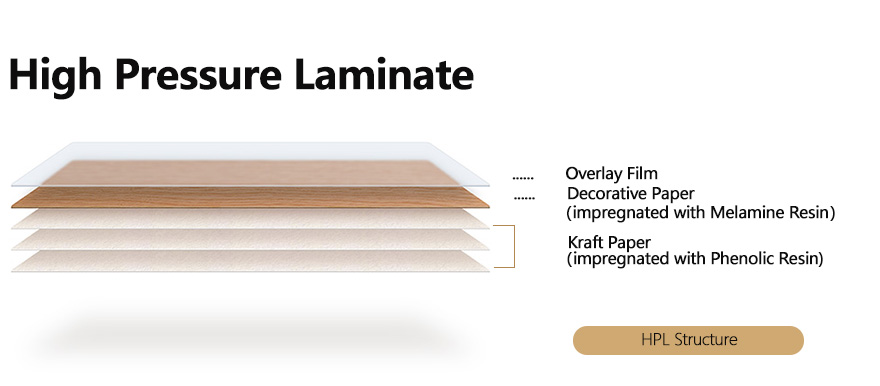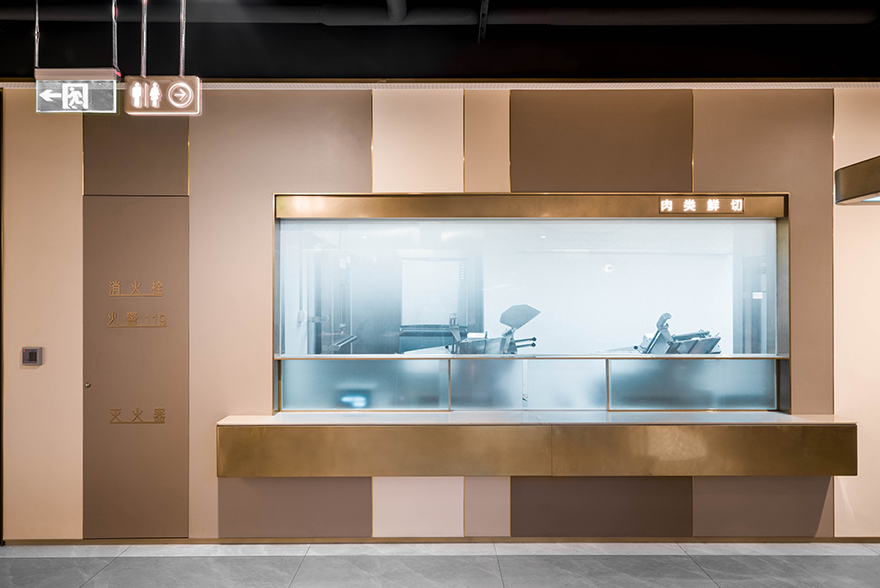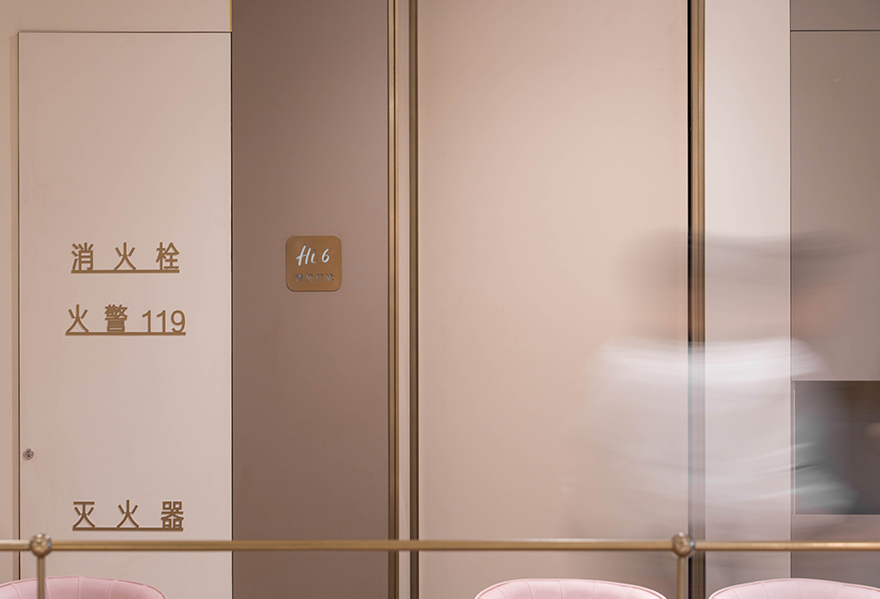Phenolic High Pressure Laminates
BODA specializes in the production of The Phenolic High Pressure Laminates, which is known as HPL. Our HPL possesses characteristics of high density, design, superior physical performance, safety and environmental protection, rapid processing, construction, installation and use. It is widely used in various decorative surfaces, such as furniture, cabinets, interior doors, partitions, countertops, decorative ceilings, walls, pillars, and more. Our hpl has covered most of Asian and North American market like Singapore, Malaysia, Thailand, Vietnam, Canada, etc.
Send Inquiry
Product Description
1. Product Details of The Phenolic High Pressure Laminates
BODA High Pressure Laminate is made of overlay film, melamine decorative paper and phenolic resin kraft paper.
BODA HPL has the advantages like: Bold and realistic designs, rich in colors, including, but not limited to solid colors, woodgrains, stones, metals, patterns, and more. Enhanced haptic solutions with a variety of surface textures. Durable wear-resistant surface. Postforming laminate sheets, which are suitable to create rounded edges for worktops and other surfaces.

2. Product Introduction of The Phenolic High Pressure Laminates
High Pressure Laminate (HPL) also known as a refractory board, is a high-tempered laminate board of thermosetting resin impregnated paper. HPL is a fire-resistant, decorative surface, building material.
Our HPL possesses characteristics of high density, design, superior physical performance, safety and environmental protection, rapid processing, construction, installation and use. It is widely used in various decorative surfaces, such as furniture, cabinets, interior doors, partitions, countertops, decorative ceilings, walls, pillars, and more. Our hpl has covered most of Asian and North American market like Singapore, Malaysia, Thailand, Vietnam, Canada, etc.

In the development process, in addition to strict implementation of quality standards and environmental standards, our company also strictly controls the supple of their materials. For domestic materials we source from companies who share our environmental protection values, including, but not limited to KINGDECO and Qifeng. Additionally, when it comes to the raw materials of our product we chose from well-known brands from Europe, the United States, and Japan, including Kapstone, Kotkamills, Munksjo, Schattdecor, Surteco, Lamigraf, Interprint, Toppan, and more. The production of environmentally friendly products and the commitment to environmental protection are the values that Boda as a company has always pursued.
3. Product Parameter (Specification) of The Phenolic High Pressure Laminates
Size Specification:
1220x2440mm (4’x8’),
1220x3050mm(4’x10’),
1525x3050mm(5’x10’),
1525x3660mm(5’x12’),
Vertical Grade Thickness: from 0.35mm to 1.9mm.
4. Product Feature And Application of The Phenolic High Pressure Laminates
BODA Phenolic high pressure laminates--HPL products are rich in surface colors, textures, and special physical properties. Characteristics include resistance to wear, scratch, impact, and high temperature. HPL is also easy to clean.
HPL is generally used on a single side and should to be attached to a substrate for proper use. HPL widely used in various interior decorative surfaces, including furniture, cabinets, interior doors, partitions, countertops, decorative ceilings, wall surfaces, pillars and more.

5. Product Qualification of The Phenolic High Pressure Laminates
BODA Phenolic high pressure laminates has gradually passed EN438, NEMA, CE, FSC, GREENGUARD and has improved the quality of inspection and monitoring throughout the entire production process. The system ensures the quality and stability of its products, simultaneously, the technical follow-up and technological innovation are continuously improved, as well as the product specifications and collections.
Within BODA’s HPL collection, there is a series of press plates, not limited to, but including antibacterial, postforming, and chemical resistant, while the deep processing and application of weather resistant properties are constantly being explored and developed.

6. Deliver, Shipping And Serving of The Phenolic High Pressure Laminates
Lead Time: 15-20 days
Shipping term is flexible: EXW, FOB, CIF, etc.
Payment Term: T/T, L/C
7. FAQ
Q: Can HPL bond over melamine or existing laminate?
A: We do not recommend bonding to existing laminate or melamine covered surfaces because they are non-porous and often prove troublesome. If you decide to try anyway, follow these five guidelines (please noted, our warranty does not cover these applications):
1. Sand the entire existing laminate surface with coarse grit sandpaper and then clean the dust off. This creates scratches for the adhesive to grip into.
2. Allow the substrates and the glue to warm up to room temperature before use and perform all bonding at room temperature.
3. Ensure 100% of the area to be bonded is covered with an adequate amount of adhesive (see product label for specific coverage amounts); be especially diligent about coverage around the perimeter.
4. Do not try mating the substrates together too soon. The substrates will be ready to bond when the film of glue on each substrate feels tacky when you firmly press your fingertip onto it. The glue is NOT ready to bond and must dry longer if the glue is still wet or if any glue actually sticks to your fingertip and creates a rubbery “leg” as you pull your finger away.
5. After mating the substrates together, use a hand-held J-roller with as much manual pressure as you can bring to bear over the entire surface. Multiple passes are recommended.
Q: How much heat can laminate stand before it discolors? How hot can be a pan be before it ruins laminate by sitting directly on the surface?
A: As a rule, a maintained temperature of 285°F can discolor a laminate. Contact adhesives typically can be reactivated or soften at around 200°F, which will allow the laminate to pull loose. The reactivation or softening of a contact adhesive will depend upon the melt point of the rubber compound. Repeated heating may cause the laminate and adhesive to react and finally deteriorate after continual exposure to temperatures above 150 degrees Fahrenheit. A pan of boiling water may be accidentally placed on a countertop without causing damage, but a hot dry pan should never be placed on a laminate countertop, since the exact temperature of the pan is unknown.
Q: Do laminates fade?
A: Laminates will fade if exposed to direct ultraviolet light, such as from an open window or external exposure. All of our colors are actually checked in a Fade-Ometer to be certain that they will maintain their normal coloration in indoor use within acceptable limits established by EN-438.
Q: How should laminates be cared for?
A: All BODA Laminate, regardless of finish, should be treated and cared for in the same way. Wash it with a soft, clean cloth and mild soap, rinse well with water, dry, and the finish will last for a long time. A soft brush may help clean the more heavily textured finishes.
Q: How do I remove stubborn stains?
A: If a stubborn stain persists, the laminate can be cleaned by wiping with 409 Formula All-Purpose Cleaner, Windex, and Isopropyl Alcohol.




















